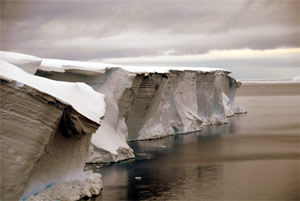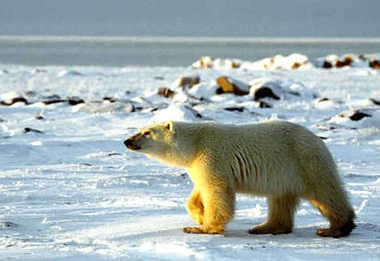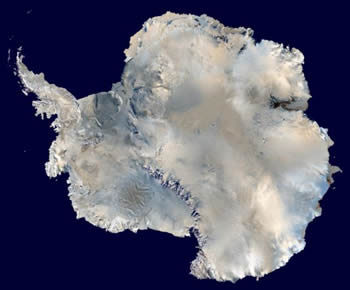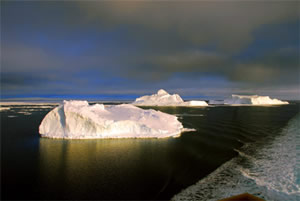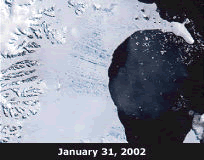
Courtesy of the National Snow and Ice Data Center
Ice Shelves
Ice shelves are a part of the Earth's cryosphere. Ice shelves are usually extensions of glaciers or ice sheets that cover the land. An ice shelf is a part of an ice sheet that extends from land out over the ocean. The ice is tethered to the land by the attached glacier or ice sheet and it is floating in the ocean water at its outer reaches.
There are ice shelves in both the north and south polar regions. In the north polar region, ice shelves can be found attached to the edges of Ellesmere Island, Canada and attached to Greenland. In the south polar region, there are many ice shelves attached to the continent of Antarctica. In fact, ice shelves in the south polar region are found along almost half of the coastline of Antarctica. The largest ice shelf in Antarctica is the Ross Ice Shelf, which is approximately the size of France.
Just like the glacial ice it is connected to, the ice in an ice shelf flows over time. As the ice flows and extends further offshore, large pieces of ice break off of the end of the ice shelf into the ocean during the summer. This process is called calving. The large chunks of ice that are calved off into the ocean are called icebergs. Antarctic ice shelves can calve icebergs that are over 80 kilometers long. This process of icebergs calving into the ocean is natural, however, more calving is happening today because of global warming.
Ice shelves act somewhat like bookends, confining a glacier or ice cap to the land. Global warming has been causing those bookends to melt. There is concern that if some of the world’s larger ice shelves were to break off into the ocean at the point where they connect to the land (called the grounding line), there would be nothing left to hold the glaciers and ice sheets on the land. The formation of icebergs from ice shelves does not cause the sea level to change because both the ice shelf and the iceberg that calves off of it are floating in the water. However, after an ice shelf breaks apart, the glacier that it had supported moves faster towards the sea, its front calving rapidly into the ocean, and sea level rises.
In February 2002, an Antarctic ice shelf called Larson B collapsed into the ocean. A few years before, the nearby Larson A Ice Shelf collapsed. Scientists have found that the ice sheet that had been supported by these ice shelves is now moving eight times faster than it was before the supporting ice shelves collapsed. If all of the ice shelves that surround the West Antarctic Ice Sheet collapsed and the ice sheet moved into the ocean, global sea level would rise approximatley 8 meters. Thirteen of the world's 20 largest cities are within a few meters of sea level today. An increase in sea level of this magnitude would flood many of them.






